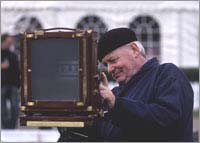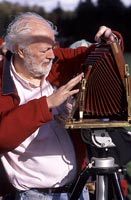It is rare to see 12 large format (10 x 8) plate cameras in operation
in one place, but this is what was organised by Terry King and Hands-On-Pictures
for the Muybridge Re-enactment at Ham Polo Ground (2 October 2004) —
an act of 'retro-invention' celebrating the centenery of the Muybridge's death.
It was a classic autumn day — blustery, with large masses of high white
cloud blowing quickly across a deep blue sky and patches of bright sunlight
restlessly shifting here and there across the polo field. The dozen cameras
and their enthusiastic operators were ranged in a line, offset from the running
track, and huddled under a series of gazebo tents flapping in the wind.
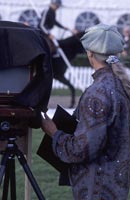 |
| Saffron Branfoot photographing the pony as it passes |
Today we take for granted that our camera shutters will be quick enough to
freeze motion. Most of us have seen Dr Edgerton's photographs of milk drop
splashes forming tiny, exploding coronets (1935) and bullets bisecting playing
cards (1964), and with modern equipment we can easily freeze Formula 1 cars
mid circuit and capture birds in flight. Before the 1870s, though, the movement
and nature of some ordinary animals and objects remained a mystery. It was
Eadweard Muybridge — a native of Kingston-on-Thames on the edge of London
— who in 1877 began to experiment with capturing photographically the
motion of a galloping racehorse. He was supported financially by the wealthy
Californian railway baron and horse enthusiast Leland Stanford, who wished
to settle a bet he had made with friends that the four feet of a running horse
would at times all be clear of the ground. Muybridge was able to demonstrate
this with his Palo Alto series of horse photographs, produced by a line of
cameras not unlike those assembled at the Ham polo field.
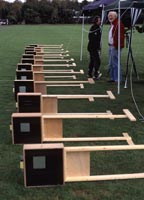 |
| Wooden shutter boxes on the polo pitch before the plate cameras arrive |
In order to record the progressive movements of a horse, each plate camera
at Ham had its lens pointed into a guillotine shutter box mounted on a tall
wooden frame. The 'guillotines' were made of aluminium sheets and sported
rubber band trigger mechanisms. Previous trials had shown, though, that the
clatter of these drop shutters scared the horses passing them, spoiling the
smooth running gait. So the shutters were dampened with Safeway foam scouring
pads — the type used for washing dishes. The set-up seemed wonderfully
Heath Robinson: crazy looking mechanics, cleverly thought out. A series of
strings ran from the shutter mechanisms of each camera across the lawn towards
the running track edge, adding to the illusion of strange grand design.
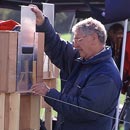 |
| The guillotine shutter is set |
The original idea had been for a polo pony to run through the assembly of
trigger cords and set off each camera in turn, to capture a series of unique
images of the horse in motion. But Ham ponies balk at such webs of string
in their path, apparently because they too closely resemble their experiences
of electric fencing! Terry King, Chairman of the Royal Photographic Society's
Historical Group, talked the crowd of spectators through some of the various
developments in preparing the re-enactment, and it quickly became clear that
a variety of other technical challenges still face anyone attempting this
type of photographic recreation even some 127 years after Muybridge.
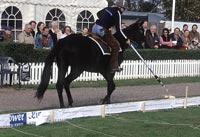 |
| Jo Baum and her mount, 'Blue', trip the trackside shutter triggers |
Jo Baum arrived mounted on her polo pony bearing a device vaguely resembling
a jousting lance. In fact it was a very-long-handled paint roller. The strings
linking the camera shutters, originally stretched across the track, were now
connected to a series of articulated trigger posts fastened to a low rail
alongside the track. As Jo and her pony charged forward, the roller was tilted
downwards onto the rail and each trigger post was mowed down in succession.
As each post fell a string was tugged, a shutter was released and an image
produced. That was the theory. After a few trial runs, the bank of photographers
formally prepared their shutters, shouted out their apertures, focussed their
ground glass plates, applied elastic mechanisms, inserted dark slides and
removed shutter safety pins.
The winds had continued to be fierce all day. The flapping canvas sheet of
one gazebo had ripped free and upset a titanic camera on a heavy Gitzo tripod,
so the temporary tent structures were taken down. This exposed the great line
of Gandolfis and Wistas and Bombay replicas to the late afternoon sun, and
it was a beautiful sight to see the brass fittings and warm rosewood casings
of these big cameras gleaming in the light.
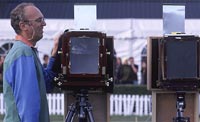 |
| A pair of 10x8 plate cameras at the ready |
Finally the first of two camera-live events was run. All triggers released
in succession and a tremendous cheer went up from the crowd as Jo and her
pony were hailed as heroes. The photographers switched plates and again prepared
their cameras. Hurrah! The second live run went smoothly — horse, rider
and jousting roller working their way down the line of triggers, metal shutters
dropping one after the other, images of horse and hooves exposed to film.
The process ran like a weird, wonderful, well-tuned machine.
All four feet off the ground? Yes, the process was successfully retro-invented!
Jim Batty
jimbatty.com
Text and photographs copyright © 2005 by Jim Batty. All rights reserved.
No part of this work may be reproduced, stored in a retrieval system, or transmitted,
in whole or in part, in any form or by any means, without signed written permission
from the author. A standard publishing fee is payable in advance for any editorial
or commercial use.

